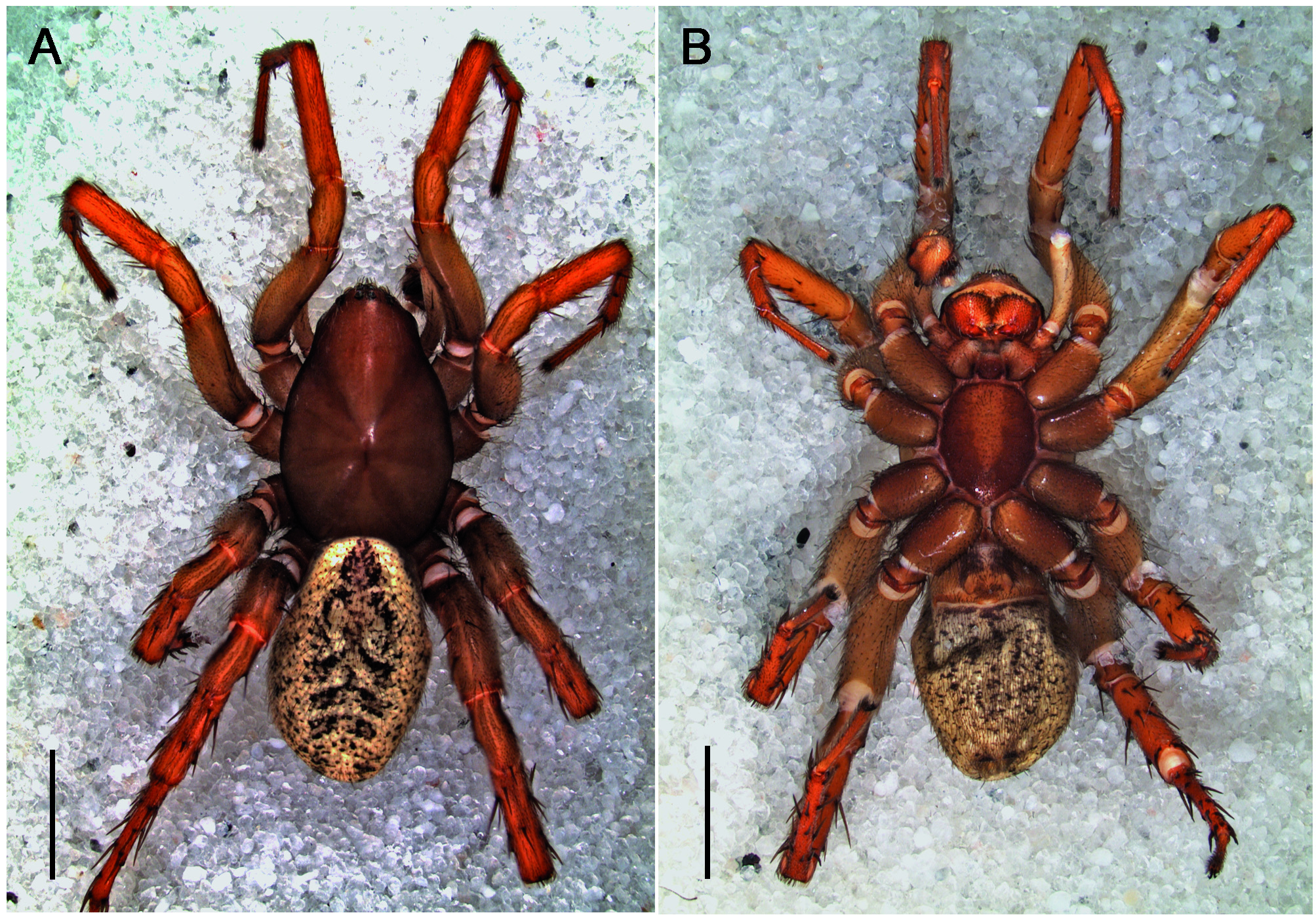Cybaeodamus lycosoides (Nicolet, 1849)
|
publication ID |
https://doi.org/10.5281/zenodo.3693112 |
|
DOI |
https://doi.org/10.5281/zenodo.3693173 |
|
persistent identifier |
https://treatment.plazi.org/id/039DC433-FFC1-3A6C-1591-4BE3FBF0F92B |
|
treatment provided by |
Cbelab20 (2020-03-01 21:11:25, last updated 2024-11-27 18:43:39) |
|
scientific name |
Cybaeodamus lycosoides (Nicolet, 1849) |
| status |
|
Cybaeodamus lycosoides (Nicolet, 1849) View in CoL
( Figures 1–4 View Fig View Fig View Fig View Fig )
Drassus lycosoides Nicolet, 1849: 453 (female).
Storena lycosoides: Simon, 1889: 218 .
Cybaeodamus lycosoides: Jocqué, 1991: 50 View in CoL ; Lise, Ott & Rodrigues, 2009: 266, f. 48–49.
Type Material. Female holotype from “ Chili ”, without data (see Lise et al. 2009: 266; MNHN 9954 ). Examined .
Material examined. CHILE: IV Región, Coquimbo, Punta de Choros, Sitio 2 , 26º70’46” S, 67º59’074” W: 2 ♀, ( MACN-Ar 17620 ), 03.VI.2005, P. Augustocoll .; 1 ♂, ( MACN-Ar 17621 ), 4.VI.2005, L. Espinoza coll . PERU: Dept. Lima, Prov. Lima, dist. La Molina , Univ. Nac. Agraria La Molina ( pitfalls in cotton fields), S 12º06’, W 76º57’, 243 m: 1 ♂, ( MEKRB, UA-524/2005), 10.VIII.2005, M. Deza coll. GoogleMaps ; 2 ♂, ( MEKRB, UA-273/2010), II. 2010, M. Deza & J. Andía coll. ; Depto. Ica , Prov. Pisco, Sector Figueroa , 10.VI.2008, J. Andía coll. 1 ♂ ( asparagus fields, MEKRB) .
Diagnosis. Males of C. lycosoides are very similar to the those of C. ornatus by general morphology of the palp, the cusps on coxae IV and the ventral patch of thickened setae on the abdomen, but differ by the shape of the distal tegular apophysis, with the two branches similar in size ( Figs. 3A, C View Fig ); the distal branch is much longer than the proximal branch in C. ornatus ), and also by the retrolateral tibial apophysis, that bears a tiny dorsal tooth ( Fig. 4A View Fig ). For the female see Lise et al., 2009 (figs. 48, 49, 52, 53), and Jocqué, 1991 (fig. 87).
Male description (MACN-Ar 17621). Total length 9.98. Carapace 5.20 long, 3.40 wide, 1.67 high. Sternum 2.40 long, 1.80 wide. Carapace broadly oval, narrower at the cephalic region ( Fig. 2A View Fig ); general color reddish brown with dark margins; glabrous, with only afew white setae on cephalic region. Chelicerae reddish brown, densely setose ( Fig. 2D View Fig ). Endites subtriangular, reddish brown, with whitish tip ( Fig. 2B View Fig ). Labium reddish brown. Sternum reddish brown with lighter central area, setae most abundant at margins ( Fig. 2B View Fig ). Anterior and posterior eye rows slightly procurved ( Fig. 2D View Fig ). Abdomen 5.07 long, 3.07 wide, 2.93 high. Color: background pale yellow with small black dots at sides and venter; the dots converge along the cardiac area in a chevron-like pattern with a more definite dark patch on the anterior part ( Fig. 1A View Fig ). Legs: coxae, trochanters and femora reddish-brown, with faint longitudinal lighter stripes; distal articles orangish brown. Leg formula 4123. Measurements I/II/III/IV: femur 3.47/3.33/3.00/3.87; patella 1.40/1.40/1.33/1.53; tibia 2.73/2.07/1.87/2.80; metatarsus 2.60/2.47/2.47/3.47; tarsus 1.87/1.53/1.60/1.80. Total 12.07/10.80/10.27/13.47. Spination: femora
I-II d1-1 pl1 III-IV d8; patellae III-IV rl1; tibiae I v8 pl2-2-1 II v8 III v2-2-2 pl2-2-1 rl0-1-1 d1-1-1 IV v2-2-2 pl1-1-1-1 rl3 d1-1-1; metatarsi Iv2-1- 2-2 II v2-2-1-2 III 18 dispersed, IV 25 dispersed. Variation: femora IV d7 (in the same specimen).
Variation. Males (5). Total length: 9.98 – 12.64; carapace: 5.00 – 6.13 (specimens from Peru are larger).
Natural history. Cybaeodamus lycosoides inhabits primarily under stones and logs, in arid areas: transitional coastal desert in Chile, and coastal valleys and Loma-vegetation in Peru. In both countries, this species was also found associated with agroecosystems ( Alcayaga et al., 2013).
Distribution. Pacific coast of Chile (Coquimbo and Atacama) and Peru (Lima and Ica).
Alcayaga, O. E., Pizarro-Araya, J., Alfaro, F. M. & Cepeda-Pizarro, J. 2013. Aranas (Arachnida, Araneae) asociadas a agroecosistemas en el Valle de Elqui (Region de Coquimbo, Chile). ReVista Colombiana de Entomologia 39: 150 - 154.
Jocque, R. 1991. Ageneric revision of the spider family Zodariidae (Araneae). Bulletin of the American Museum of Natural History 201: 1 - 160.
Lise, A. A., Ott, R. & Rodrigues, E. N. L. 2009. On the Neotropical genus Cybaeodamus (Araneae, Zodariidae, Storeninae). Iheringia, Serie Zoologia 99: 259 - 272.
Fig. 1. Cybaeodamus lycosoides (Nicolet, 1849), male from Punta de Choros (MACN-Ar 17621), habitus. A, dorsal. B, ventral. Scale bars: 2.5 mm.
Fig. 2. Cybaeodamus lycosoides (Nicolet, 1849), male from Punta de Choros (MACN-Ar 17621), prosoma. A, dorsal. B, ventral. C, lateral. D, frontal. Scale bars: 1 mm.
Fig. 3. Cybaeodamus lycosoides (Nicolet, 1849), male from Punta de Choros (MACN-Ar 17621), left palp. A, ventral. B, prolateral. C, ventral-prolateral, close-up of the distal tegular apophysis. D, retrolateral. Abbreviations: dta, distal tegular apophysis; mta, median tegular apophysis; t, tegulum. Scale bars: 7-8, 10: 0.5 mm; 9: 0.2 mm.
| MEKRB |
MEKRB |
No known copyright restrictions apply. See Agosti, D., Egloff, W., 2009. Taxonomic information exchange and copyright: the Plazi approach. BMC Research Notes 2009, 2:53 for further explanation.
|
Kingdom |
|
|
Phylum |
|
|
Class |
|
|
Order |
|
|
Family |
|
|
Genus |
Cybaeodamus lycosoides (Nicolet, 1849)
| Grismado, Juan Manuel Andía & Cristian J. 2015 |
Cybaeodamus lycosoides : Jocqué, 1991: 50
| : Jocque 1991: 50 |
Storena lycosoides :
| Simon 1889: 218 |
Drassus lycosoides
| Nicolet 1849: 453 |
1 (by cbelab20, 2020-03-01 21:11:25)
2 (by ExternalLinkService, 2020-03-01 21:21:30)
3 (by ExternalLinkService, 2020-03-01 22:52:03)
4 (by tatiana, 2021-01-07 20:05:15)
5 (by ExternalLinkService, 2022-01-30 03:23:57)
6 (by admin, 2023-08-31 21:12:50)
7 (by ExternalLinkService, 2023-08-31 21:22:56)
8 (by ExternalLinkService, 2023-08-31 21:48:03)
9 (by plazi, 2023-10-31 03:38:27)




